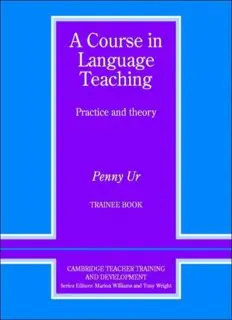Table Of ContentA Course in Language Teaching
CAMBRIDGE TEACHER TRAINING AND DEVELOPMENT
Series Editors: Marion Williams and Tony Wright
This series is designed for all those involved in language teacher training and development:
teachers in training, trainers, directors of studies, advisers, teachers of in-service courses and
seminars. Its aim is to provide a comprehensive, organised and authoritative resource for
language teacher training development.
Teach English– A training course for teachers
by Adrian Doff
Training Foreign Language Teachers– A reflective approach
by Michael J. Wallace
Literature and Language Teaching– A guide for teachers and trainers*
by Gillian Lazar
Classroom Observation Tasks– A resource book for language teachers and trainers*
by Ruth Wajnryb
Tasks for Language Teachers– A resource book for training and development*
by Martin Parrott
English for the Teacher– A language development course*
by Mary Spratt
Teaching Children English– A training course for teachers of English to children*
by David Vale with Anne Feunteun
A Course in Language Teaching– Practice and theory
by Penny Ur
Looking at Language Classrooms– A teacher development video package
About Language– Tasks for teachers of English
by Scott Thornbury
Action Research for Language Teachers
by Michael J. Wallace
Mentor Courses– A resource book for trainer-trainers
by Angi Malderez and Caroline Bodóczky
Alive to Language– Perspectives on language awareness for English language teachers
by Valerie Arndt, Paul Harvey and John Nuttall
Teachers in Action– Tasks for in-service language teacher education and development
by Peter James
Advising and Supporting Teachers
by Mick Randall with Barbara Thornton
* Original Series Editors: Ruth Gairns and Marion Williams
A Course in Language
Teaching
TraineeBook
Penny Ur
publishedbythepresssyndicateoftheuniversityofcambridge
ThePittBuilding,TrumpingtonStreet,CambridgeCB21RP,UnitedKingdom
cambridgeuniversitypress
TheEdinburghBuilding,CambridgeCB22RU,UnitedKingdom
40West20thStreet,NewYork,NY10011–4211,USA
10StamfordRoad,Oakleigh,Melbourne3166,Australia
©CambridgeUniversityPress1999
Thisbookisincopyright.Subjecttostatutoryexceptionandtotheprovisions
ofrelevantcollectivelicensingagreements,noreproductionofanypartmay
takeplacewithoutthewrittenpermissionofCambridgeUniversityPress.
Firstpublished1999
PrintedintheUnitedKingdomattheUniversityPress,Cambridge
TypesetinSabon10.5/12.5pt[vn]
AcataloguerecordforthisbookisavailablefromtheBritishLibrary
LibraryofCongressCataloguinginPublicationdataappliedfor
ISBN0521656249paperback
Contents
Acknowledgements ix
Tothetrainer xi
Tothetrainee xii
PartI Theteachingprocess
Module1:Presentationsandexplanations
UUnniitt TOhnree:e: Effectivepresentation 1
Unit Two: Examplesofpresentationprocedures 1
Unit Three: Explanationsandinstructions 3
Module2:Practiceactivities
Unit One: Thefunctionofpractice 4
Unit Two: Characteristicsofagoodpracticeactivity 4
Unit Three: Practicetechniques 5
Unit Four: Sequenceandprogressioninpractice 7
Module3:Tests
Unit One: Whataretestsfor? 9
Unit Two: Basicconcepts;thetestexperience 10
Unit Three: Typesoftestelicitationtechniques 12
Unit Four: Designingatest 14
Unit Five: Testadministration 15
PartII Teachingthelanguage(1):The‘what’
Module4:Teachingpronunciation
Unit One: Whatdoesteachingpronunciationinvolve? 16
Unit Two: Listeningtoaccents 17
Unit Three: Improvinglearners’pronunciation 19
Unit Four: Furthertopicsfordiscussion 20
Unit Five: Pronunciationandspelling 21
Module5:Teachingvocabulary
Unit One: Whatisvocabularyandwhatneedstobetaught? 23
Unit Two: Presentingnewvocabulary 24
v
Contents
Unit Three: Rememberingvocabulary 25
Unit Four: Ideasforvocabularyworkintheclassroom 26
Unit Five: Testingvocabulary 27
Module6:Teachinggrammar
Unit One: Whatisgrammar? 30
Unit Two: Theplaceofgrammarteaching 30
Unit Three: Grammaticalterms 31
Unit Four: Presentingandexplaininggrammar 32
Unit Five: Grammarpracticeactivities 33
Unit Six: Grammaticalmistakes 35
Module7:Topics,situations,notions,functions
Unit One: Topicsandsituations 36
Unit Two: WhatAREnotionsandfunctions? 37
Unit Three: Teachingchunksoflanguage:fromtexttotask 37
Unit Four: Teachingchunksoflanguage:fromtasktotext 38
Unit Five: Combiningdifferentkindsoflanguagesegments 40
PartIII Teachingthelanguage(2):The‘how’
Module8:Teachinglistening
Unit One: Whatdoesreal-lifelisteninginvolve? 41
Unit Two: Real-lifelisteningintheclassroom 41
Unit Three: Learnerproblems 42
Unit Four: Typesofactivities 43
Unit Five: Adaptingactivities 44
Module9:Teachingspeaking
Unit One: Successfuloralfluencypractice 48
Unit Two: Thefunctionsoftopicandtask 48
Unit Three: Discussionactivities 49
Unit Four: Otherkindsofspokeninteraction 53
Unit Five: Roleplayandrelatedtechniques 54
Unit Six: Oraltesting 56
Module10:Teachingreading
Unit One: Howdoweread? 57
Unit Two: Beginningreading 59
Unit Three: Typesofreadingactivities 59
Unit Four: Improvingreadingskills 61
Unit Five: Advancedreading 64
Module11:Teachingwriting
Unit One: Writtenversusspokentext 68
Unit Two: Teachingprocedures 69
vi
Contents
Unit Three: Tasksthatstimulatewriting 70
Unit Four: Theprocessofcomposition 71
Unit Five: Givingfeedbackonwriting 73
PartIV Coursecontent
Module12:Thesyllabus
Unit One: Whatisasyllabus? 76
Unit Two: Differenttypesoflanguagesyllabus 76
Unit Three: Usingthesyllabus 77
Module13:Materials
Unit One: Hownecessaryisacoursebook? 79
Unit Two: Coursebookassessment 81
Unit Three: Usingacoursebook 82
Unit Four: Supplementarymaterials 84
Unit Five: Teacher-madeworksheetsandworkcards 85
Module14:Topiccontent
Unit One: Differentkindsofcontent 86
Unit Two: Underlyingmessages 87
Unit Three: Literature(1):shoulditbeincludedinthecourse? 88
Unit Four: Literature(2):teachingideas 90
Unit Five: Literature(3):teachingaspecifictext 92
PartV Lessons
Module15:Lessonplanning
Unit One: Whatdoesalessoninvolve? 95
Unit Two: Lessonpreparation 95
Unit Three: Varyinglessoncomponents 96
Unit Four: Evaluatinglessoneffectiveness 98
Unit Five: Practicallessonmanagement 100
Module16:Classroominteraction
Unit One: Patternsofclassroominteraction 101
Unit Two: Questioning 102
Unit Three: Groupwork 105
Unit Four: Individualization 106
Unit Five: Theselectionofappropriateactivationtechniques 108
Module17:Givingfeedback
Unit One: Differentapproachestothenatureandfunctionof
feedback 110
Unit Two: Assessment 112
Unit Three: Correctingmistakesinoralwork 113
vii
Contents
Unit Four: Writtenfeedback 115
Unit Five: Clarifyingpersonalattitudes 118
Module18:Classroomdiscipline
Unit One: Whatisdiscipline? 120
Unit Two: Whatdoesadisciplinedclassroomlooklike? 120
Unit Three: Whatteacheractionisconducivetoadisciplined
classroom? 121
Unit Four: Dealingwithdisciplineproblems 122
Unit Five: Disciplineproblems:episodes 123
PartVI Learnerdifferences
Module19:Learnermotivationandinterest
Unit One: Motivation:somebackgroundthinking 126
Unit Two: Theteacher’sresponsibility 126
Unit Three: Extrinsicmotivation 127
Unit Four: Intrinsicmotivationandinterest 128
Unit Five: Fluctuationsinlearnerinterest 128
Module20:Youngerandolderlearners
Unit One: Whatdifferencedoesagemaketolanguagelearning? 130
Unit Two: Teachingchildren 130
Unit Three: Teachingadolescents:studentpreferences 131
Unit Four: Teachingadults:adifferentrelationship 133
Module21:Largeheterogeneousclasses
Unit One: Definingterms 134
Unit Two: Problemsandadvantages 134
Unit Three: Teachingstrategies(1):compulsory+optional 136
Unit Four: Teachingstrategies(2):open-ending 137
Unit Five: Designingyourownactivities 139
References 142
viii
Acknowledgements
Theauthorsandpublishersaregratefultotheauthors,publishersandothers
whohavegiventheirpermissionfortheuseofcopyrightinformationidentified
inthetext.Whileeveryendeavourhasbeenmade,ithasnotbeenpossibleto
identifythesourcesofallmaterialusedandinsuchcasesthepublisherswould
welcomeinformationfromcopyrightsources.
p2from‘Exploitingtextbookdialoguesdynamically’byZoltanDo¨rnyei,first
publishedinPracticalEnglishTeaching,1986,6/4:15–16;pp2–3from
‘Excuses,excuses’byAlisonCoulavin,firstpublishedinPracticalEnglish
Teaching,1983,4/2:31©MaryGlasgowMagazinesLtd/Scholastic,
London;p3fromTheEnglishTeachers’Journal,1986,33;p16from
PronunciationTasksbyMartinHewings,CambridgeUniversityPress,1993;
pp30–1(extracts1and2)from‘Hownottointerferewithlanguagelearning’
byL.Newmarkand(extract3)from‘Directionsintheteachingofdiscourse’
byH.G.WiddowsoninTheCommunicativeApproachtoLanguage
TeachingbyC.J.BrumfitandK.Johnson(eds.),©OxfordUniversityPress,
1979,bypermissionofOxfordUniversityPress;p31(extract4)from
AwarenessofLanguage:AnIntroductionbyEricHawkins,Cambridge
UniversityPress,1984;p46adaptedfromTeachingListeningComprehension
byPennyUr,CambridgeUniversityPress,1984;p53fromTheLanguage
TeachingMatrixbyJackC.Richards,CambridgeUniversityPress,1990;p54
(extract2)fromTeachingtheSpokenLanguagebyGillianBrownandGeorge
Yule,CambridgeUniversityPress,1983,and(extract3)fromDiscussions
thatWorkbyPennyUr,CambridgeUniversityPress,1981;p55fromRole
PlaybyG.PorterLadousse,©OxfordUniversityPress,1987,bypermission
ofOxfordUniversityPress;p64fromTaskReadingbyEvelyneDavis,
NormanWhitney,MeredithPike-BlakeyandLaurieBass,Cambridge
UniversityPress,1990;p65fromPointsofDeparturebyAmosParan,Eric
CohenBooks,1993;p66fromEffectiveReading:SkillsforAdvanced
StudentsbySimonGreenallandMichaelSwan,CambridgeUniversityPress,
1986,BeattheBurglar,MetropolitanPolice;pp68–9fromTeachingWritten
EnglishbyRonaldV.White,HeinemannEducationalBooks,1980,by
permissionofR.White;p93‘Teevee’fromCatchaLittleRhymebyEve
Merriam©1966EveMerriam.©renewed1994DeeMichelandGuy
Michel.ReprintedbypermissionofMarianReiner;p116fromEnglish
GrammarinUsebyRaymondMurphy,CambridgeUniversityPress,1985;
pp124–5(episode1and3)frompages12and18ofClassManagementand
ControlbyE.C.Wragg,Macmillan,1981,(episode2and5)adaptedfrom
ix

